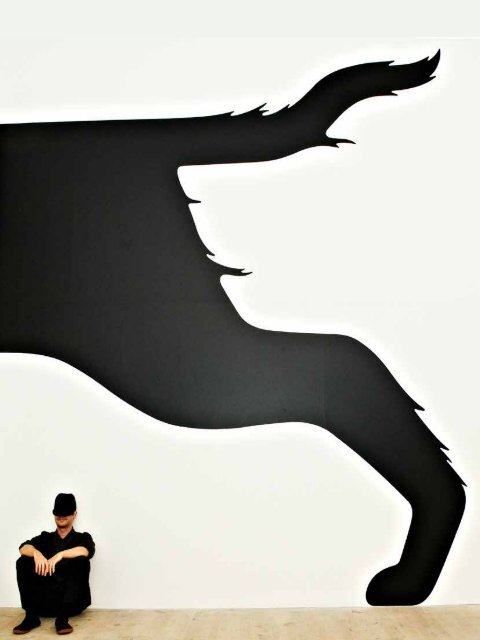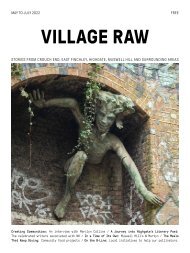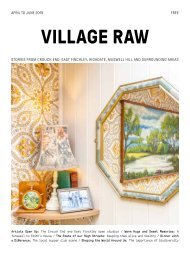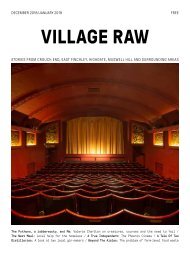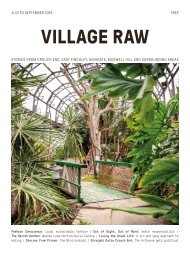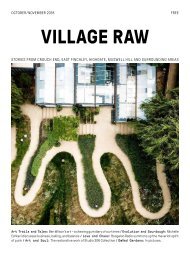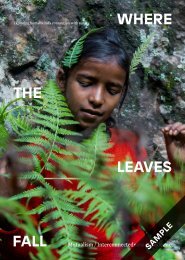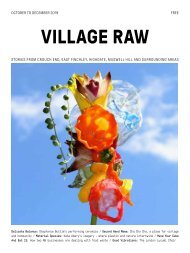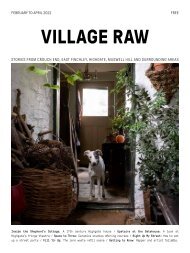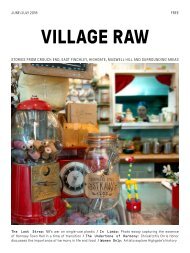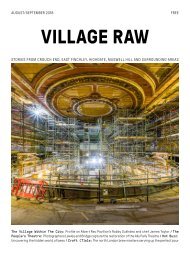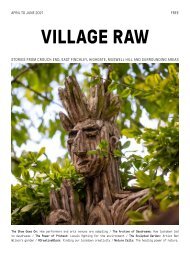Village Raw - ISSUE 9
Village Raw is a magazine that explores cultural stories from Crouch End, East Finchley, Highgate, Muswell Hill and the surrounding areas. The magazine is created by the community, for the community. If you like this issue you can support the project through a subscription or donation. See the links below. The ninth issue of Village Raw magazine includes: DOUBLE TAKE - Noma Bar - the illusionary storyteller. SOUNDS FROM THE CITY, SOUNDS FROM THE SEA - Singer-songwriter Austel on her musical journey. MR TOMMY HILL KNOWS - A new project from the artist previously known as WILLIAM. THE COLLODION WAY - John Hoare and his 19th century collodion photographic portraits. WITH. NOT FOR. - Wave Cafe – pushing boundaries and changing attitudes. BRIGHT ORANGE TILES - Revisiting Hornsey Town Hall to see how the restoration is progressing. WHERE THERE’S A WILL, THERE’S A WAY - Planting trees for the future. PLANT POWER - The healing power of plants with Handmade Apothecary. A GREAT WASTE OF TIME - Creating a compost lasagne. THE NORTH LONDON CHEESE HUNT - Meeting the local cheesemongers and producers. AND MORE…
Village Raw is a magazine that explores cultural stories from Crouch End, East Finchley, Highgate, Muswell Hill and the surrounding areas. The magazine is created by the community, for the community. If you like this issue you can support the project through a subscription or donation. See the links below. The ninth issue of Village Raw magazine includes:
DOUBLE TAKE - Noma Bar - the illusionary storyteller.
SOUNDS FROM THE CITY, SOUNDS FROM THE SEA - Singer-songwriter Austel on her musical journey.
MR TOMMY HILL KNOWS - A new project from the artist previously known as WILLIAM.
THE COLLODION WAY - John Hoare and his 19th century collodion photographic portraits.
WITH. NOT FOR. - Wave Cafe – pushing boundaries and changing attitudes.
BRIGHT ORANGE TILES - Revisiting Hornsey Town Hall to see how the restoration is progressing.
WHERE THERE’S A WILL, THERE’S A WAY - Planting trees for the future.
PLANT POWER - The healing power of plants with Handmade Apothecary.
A GREAT WASTE OF TIME - Creating a compost lasagne.
THE NORTH LONDON CHEESE HUNT - Meeting the local cheesemongers and producers.
AND MORE…
You also want an ePaper? Increase the reach of your titles
YUMPU automatically turns print PDFs into web optimized ePapers that Google loves.
VILLAGE RAW<br />
ART & CULTURE<br />
DOUBLE TAKE<br />
Graphic designer, illustrator and artist Noma Bar challenges conventional<br />
wisdom through a play with visual perception.<br />
Words by Lito Apostolakou. Artworks by Noma Bar.<br />
PHOTO BY SARAH DEANE.<br />
There is an irresistible lure in Noma Bar’s bold, minimalist imagery.<br />
It ensnares the viewer’s gaze in a constant perceptual reversal.<br />
Within what the eye perceives as one image lies another<br />
one which exists in opposition to the first. Together they create<br />
a unity of opposites. Yet we cannot see both at the same time.<br />
Our gaze shifts from one to the other in a journey of discovery<br />
of parallel - or conflicting realities. Noma uses negative space to<br />
produce striking images whose interpretation requires a double<br />
take. He has been called a “master of visual illusion,” but it is not<br />
for their illusory qualities his illustrations are sought the world<br />
over - they tell powerful stories.<br />
“I am not interested in any visual trickery,” says Noma. “I am<br />
interested in the story. We are in a reality that has two sides. We<br />
are born into conflict.” In his native Israel Noma became aware<br />
very early on of the polarisation and intransigence that conflict<br />
generates as each side becomes entrenched in its own beliefs<br />
and unable to entertain the other’s views. The ever present Israeli-Palestinian<br />
conflict has been part of his life. And conflict is<br />
what his illustrations engage with but without becoming inflexible<br />
propositions or monolithic aphorisms. Noma deploys negative<br />
space to depict alternative versions of reality and perspectives<br />
not apparent at first glance. His illustrations contain two images<br />
interlocked with each other - forcing the mind to alternate<br />
between interpretations. Both images cannot be seen at once,<br />
and this tension and unity of opposites opens up conversations<br />
about social and political issues.<br />
Looking for images within images, Noma discovers: “things<br />
that do not exist and yet they are around us.” Shapes and forms<br />
that you perceive with unseeing eyes every day - taking them for<br />
granted - hide something else. Then, one day you make the discovery.<br />
“If you look at places people don’t look at, you become<br />
more aware, more sensitive to things, to social and political problems,”<br />
says Noma. It is through this process of discovery and conscious<br />
looking that a script is created and a story is built. The<br />
process of discovery is essentially a painstaking process of distillation:<br />
“to take the complexity of a political problem and to distil<br />
it to one thing, one element.”<br />
If Noma’s artworks initially produce a visual punch with their<br />
bold colours and economy of line, they also compel the viewer to<br />
read them. They are wordless narratives. The eye peels off their<br />
layers and reveals the story they are telling. Noma’s idiom has<br />
been partly a product of his experience as a young designer moving<br />
to London some 20 years ago. Away from his country of birth<br />
and with English far from fluent, he struggled with the new world<br />
he threw himself into. His Hebrew type design expertise didn’t get<br />
him far and, as his wife recalls, he grew especially quiet. “I lost my<br />
language,” he remembers. Yet this uprooting acted as a powerful<br />
creative force. Noma developed a visual vocabulary and created<br />
a new “silent” language that needed no dictionary. The distance<br />
from his native environment enabled him to see beyond the familiar,<br />
to overcome the unconscious prejudices of custom and<br />
convention, crafting a visual language that cuts through cultural<br />
and linguistic barriers.<br />
Noma’s art dislodges conventional ways of seeing and brings<br />
together recognisable forms to propose a different take on reality.<br />
This intellectual leap requires a space where the mind can<br />
distance itself from the mundane and discover what hides in<br />
plain sight. This space Noma finds in Highgate Woods, the ancient<br />
20 07


